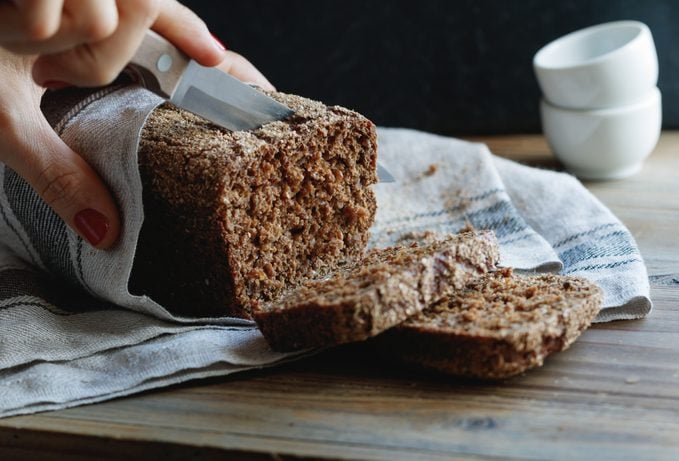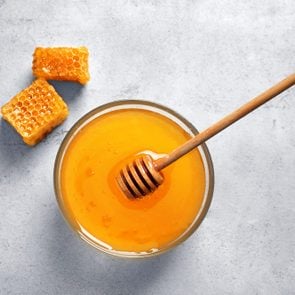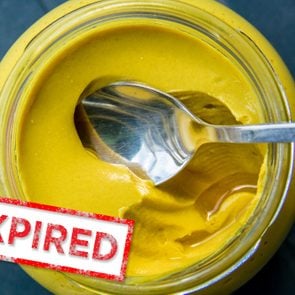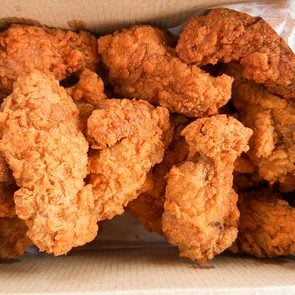This Is What Happens If You Accidentally Eat Mold
Updated: Oct. 13, 2022
It's tempting to cut away mold and eat the rest of your food. Not so fast! Experts explain what happens if you eat mold, and how to handle moldy foods.
Will eating mold make you sick?
You are enjoying your breakfast when you notice that your banana muffin seems to have grown a patch of fuzzy green dots. You have already taken a bite or two. Now, you wonder, what happens if you eat mold? First, don’t panic. Most healthy people can accidentally eat some mold here and there and feel totally fine. A lot depends on the type of food (after all, some foods, like Roquefort, gorgonzola and other blue cheeses are made with mold cultures), the type of mold (there are at least 300,000 varieties, according to the United States Department of Agriculture) and on your underlying health status.
To understand which molds you should avoid, and which ones are not as harmful, here’s a debrief on molds.
Get The Healthy @Reader’s Digest newsletter
What are molds?
Molds are microscopic fungi that can grow on wood, paper, carpet, food and building materials such as insulation. All molds need water or moisture to grow. Wherever there is moisture and oxygen, mold can grow—and this includes your old mattress.
Because there are so many types of mold, the type that pops up on your breakfast muffin may look different than the furry layer that grows on your lunch meats, explains Elena Ivanina, DO, gastroenterologist, Lenox Hill Hospital, New York City.
Unlike bacteria, molds grow in structures that contain many cells, and you don’t need a microscope to see them. In general, molds consist of root threads that run deep into food, a stalk that rises above the food and spores at the end of the stalks. Spores give mold its variety of colors and also help transport it from item to item.
Where Does Mold Grow at Home? A Mold Pro’s 7 Surprising Spots
“If you pick up a dandelion and blow on it, the seeds disperse in the air, and that’s how mold spores travel from place to place, contaminate products and cause spoilage,” says Robert Gravani, professor and director of the National Good Agricultural Practices Program, Cornell’s College of Agriculture and Life Sciences, Ithaca, New York.
“Molds are nature’s decomposers. If you have a fruit with mold, eventually that fruit will be decomposed,” says Gravani. “Molds are very efficient in what they do.”
Mold thrives in warm, humid environments, but that doesn’t mean it can’t also form and grow in your refrigerator. Molds are pretty smart, too, and tolerate preservatives such as salt and sugar better than most other food invaders. “They are pretty hearty critters,” Gravani says.
14 Health Effects of Mold in Your Home, from an Air Quality Scientist

The good and bad types of mold
Not all molds are bad. In fact, some can be very beneficial. The life-saving antibiotic penicillin is made from Penicillium mold, Dr. Ivanina notes. Certain hard cheeses are also made from mold, she says.
Allergic reactions to mold
Some people are allergic to mold, says Dr. Ivanina. This is usually mold in the environment as opposed to food, but for these people, exposure to mold can cause vomiting, diarrhea, or headaches. If your doctor suspects a mold allergy is to blame, you will likely be referred for testing, she says.
Hidden patches of mold can lurk in all different areas of your home and may make you sick.
“If you have an underlying health condition that affects your immune system, exposure to mold can be dangerous,” Dr. Ivanina says. “You may have a much worse reaction to eating mold than someone else because you don’t have a healthy immune system to fight that reaction.”
The #1 Best Fall Allergy Fix, from a Yale Medicine Allergist
Some molds produce poisonous substances
A few molds produce mycotoxins, or poisonous substances that can make you very sick. For example, molds produced by the Aspergillus species can cause aflatoxicosis, a life-threatening form of acute poisoning with the potential to cause liver damage.
This type of mold tends to lurk in cereals; oilseeds, such as soybean, peanut, sunflower and cotton seeds; spices; and tree nuts. These mycotoxins have been linked to cancer in animals and can cause liver cancer in humans. “Some are highly toxic, which can get you really sick or cause cancer,” says Gravani.
How to handle moldy foods
When it comes to food, it can be tempting to cut away mold and eat it anyway, given the high price tags of certain products, but it’s usually not worth it, Gravani says.
Besides the risk of illness, moldy food doesn’t taste great, he says. Most molds on soft foods will taste like soil or dust. Tip: Never sniff the mold to make sure it’s mold, the USDA advises. If it looks like mold, it likely is mold, and smelling it can cause respiratory issues.
When in doubt, throw it out, Dr. Ivanina says. This is a good motto for moldy foods, but there are some more specific guidelines to keep in mind too.
If your moldy food is not on this list, there’s a free app that can tell you what to do if you find mold on 600 types of food. The FoodKeeper app was developed by the USDA’s Food Safety and Inspection Service with Cornell University and the Food Marketing Institute. “It offers rough guidelines to the question, how long can I keep this?'” says Gravani.
14 Food Parts You Should Never Throw in the Garbage
Cheese
There are different rules for cheese depending on its texture.
Hard cheese
Hard cheeses (not to be mistaken with those that have mold as part of the process) can be consumed if you cut off at least 1-inch around and below the mold. Make sure to keep the knife away from the mold to avoid spreading it. Still, Gravani adds, “If the hard cheese is heavily encrusted with mold, I would probably discard it.”
Soft cheese
If you see mold on soft cheese such as cottage, cream cheese or all types of crumbled, shredded and sliced cheeses, throw it out. These may be contaminated below the surface and can also have bacteria growing along with the mold.
Some cheeses are made with mold, such as Roquefort, blue, Gorgonzola, Stilton, Brie and Camembert. If they contain molds that are not a part of the manufacturing process, these cheeses can be dangerous.
Texture is a good rule of thumb with these types of cheese as well. Discard soft cheeses if they contain molds that are not a part of the manufacturing process, and cut surface mold on hard cheeses such as Gorgonzola and Stilton.
Can People With Diabetes Eat Cheese?
Fruits and vegetables
Like cheese, there are different rules for fruits and vegetables based on the texture.
Soft produce
Discard soft fruits and veggies like cucumbers, peaches and tomatoes if you spy any mold. Many of these may also be contaminated under the surface, says Dr. Ivanina.
What you see isn’t all that you get with molds. “Root” threads from the mold tend to run deep, especially in foods that show heavy mold growth.
Firm produce
You can keep these if you cut out all the mold. This is due to the low moisture content in firm fruits and veggies like cabbage, bell peppers and carrots. With these types of foods, mold can’t penetrate them easily.
4 Easy Tips for Safer Fruit and Vegetable Washing, from Food Safety and Nutrition Authorities
Luncheon meats, bacon, or hot dogs
The rule of thumb for these types of food is to discard. These may also be contaminated under the surface and could also harbor bacteria, Dr. Ivanina says.
Hard salami and dry-cured country hams
You can keep these meats if you scrub off all of the surface mold. The USDA points out that it is normal for these shelf-stable products to grow surface mold.
The 5 Best Healthy Meats to Eat—and 2 to Avoid
Cooked casseroles and leftover meat and poultry
Get rid of these if you see mold as there is a good chance it runs deep and it may travel with bacteria. It’s also a smart idea to use or get rid of leftovers within three or four days.
Cooked grains and pasta
Like other leftovers, if you see mold on cooked grains or pasta, toss it. There is likely mold under the surface too and there’s also a risk of bacteria.
Yogurt and sour cream
If you see mold, get rid of yogurt and sour cream immediately. Mold is likely growing beneath the surface too, and there’s a good chance that the mold is traveling with bacteria.
Jams and jellies
These should be trashed if you see any mold. These foods could be producing a mycotoxin if they develop mold, which is why microbiologists warn never to scoop out the mold and use the remains.
Bread and baked goods
Get rid of moldy bread and baked goods, says Dr. Ivanina. “Mold can spread really fast on soft things like breads and muffins.”
Peanut butter, legumes, and nuts
Discard these because foods processed without preservatives are at high risk for mold.
How to avoid eating mold
Preventing mold from forming can go a long way toward preserving your food supply and eliminating waste. This starts by storing fruits and vegetables in individual plastic bags in your produce drawer.
Keep food covered when serving to prevent exposure to mold spores in the air, and use plastic wrap to cover foods you want to stay moist to keep mold away.
You’ve Probably Been Storing These 12 Foods Wrong this Whole Time
Don’t forget to always empty open cans of perishable foods into clean containers and refrigerate them right away. And never leave any perishables out of the refrigerator for more than two hours.
Clean out your refrigerator and bread drawer often, Gravani says. Also, as a rule of thumb: “Toss out the food when you spot mold as it will travel and invade the rest of your food, too.”
For more wellness updates, follow The Healthy on Facebook, Instagram, and Twitter. Keep reading:





